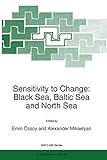Sensitivity to Change : Black Sea, Baltic Sea and North Sea Libro electrónico editors: Emin Özsoy, Alexander Mikaelyan
Tipo de material: Libro
en línea Idioma: Inglés Detalles de publicación: Dordrecht Springer science c1997Descripción: xxiv, 516 páginas diagrs., gráf., ilustraciones, mapas centímetrosISBN:
Libro
en línea Idioma: Inglés Detalles de publicación: Dordrecht Springer science c1997Descripción: xxiv, 516 páginas diagrs., gráf., ilustraciones, mapas centímetrosISBN: - 9401064296
- 9789401064293
- 9789401157582 (Online)
- Disponible en línea
Incluye bibliografía e índice: páginas 509-516
Disponible para usuarios de ECOSUR con su clave de acceso
Recent decades have seen a degradation of the environmental quality in semi-enclosed seas, which are particularly sensitive to population pressures due to their naturally low flushing rates related to their geometry. The North Sea, Baltic Sea and the Black Sea are amongst the most seriously threatened seas in the Euro-Asian region. Each semi-enclosed sea has a distinct pattern of circulation, transport, mixing, associated with the particular geometry, topography, boundary processes, interior stratification, atmospheric forcing, ice fonnation, straits / sill controls, and the specific inputs of freshwater, nutrients and pollutants. The workshop investigated the distinctive physical and ecological characteristics of the three seas in a comparative manner, in order to identify the types of driving forces and dynamic controls operating on productivity, nutrient cycling, physical transport and mixing mechanisms. A comparative study of these controlling mechanisms would allow us to better understand ecosystem sensitivity in these different environments. The workshop presentations highlighted the complexity of the semi-enclosed seas related to the interaction amongst the physical, chemical and biological fields, and differences in time and space scales in each of the systems. Further, a strong climate signal exists in these systems, manifest in the interannual, interdecadal and longer term variability. Part of the variability appears connected with background climatic variability. Inglés
Disponible en línea
Disponible en formato PDF


